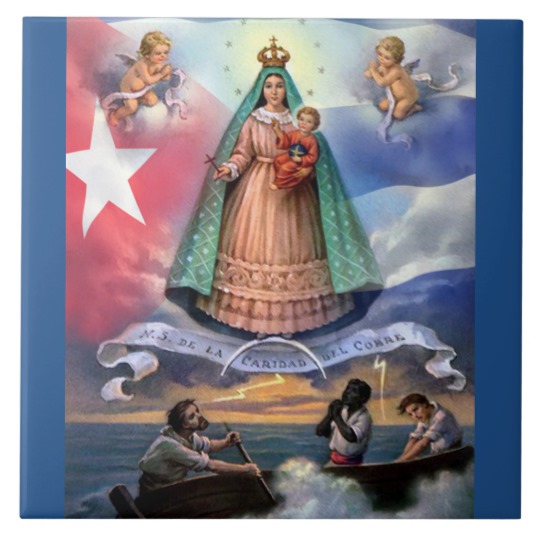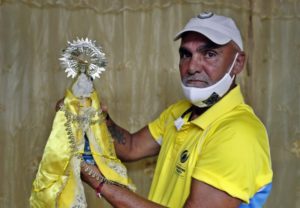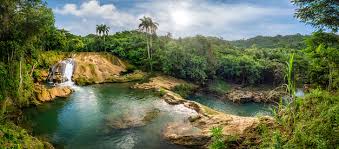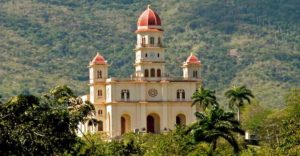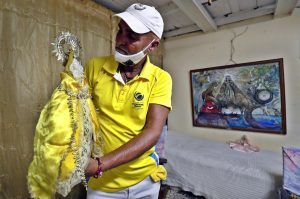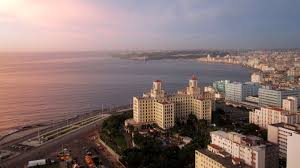DURANTE La gesta independentista de Cuba contra la colonia española nuestros mambises se encomendaron a la advocación de la Virgen de la Caridad del Cobre. Y, en 1915, esos propios veteranos de las guerras patrias le pidieron al Papa que la declarase Patrona de Cuba.
La misiva cursada a Benedicto XV rezaba así: “No pudieron ni los azares de la guerra, ni los trabajos para librar nuestra subsistencia, apagar la fe y el amor que nuestro pueblo católico profesa a esa Virgen venerada; y antes al contrario, en el fragor de los combates y en las mayores vicisitudes de la vida, cuando más cercana estaba la muerte o más próxima la desesperación, surgió siempre como luz disipadora de todo peligro o como rocío consolador para nuestras almas, la visión de esa Virgen cubana por excelencia, cubana por el origen de su secular devoción, y cubana porque así la amaron nuestras madres inolvidables, así la bendicen nuestras amantes esposas y así la han proclamado nuestros soldados”.
LA VIRGEN DEL COBRE, PATRONA DE CUBA..
No tardó en responder el Sumo Pontífice. En 1916, Benedicto XV les concedió la petición y fijó su festividad para el 8 de septiembre. Ocurrió el 10 de mayo de ese año, la fecha cuando proclamó a la Virgen de la Caridad del Cobre como Patrona de Cuba.
El actual Santuario donde se conserva la imagen mariana fue inaugurado justo el 8 de septiembre de 1927 y –medio siglo después– el Papa Pablo VI elevó el recinto a la dignidad de Basílica.
Para 1936, había sido canonizada, ante una solicitud de la Iglesia Católica al Vaticano. Visitaron su templo, además de Juan Pablo II, hace ahora dos décadas; Benedicto XVI, 14 años después de aquel; y Francisco, en el 2015.
De acuerdo con lo recogido por la tradición religiosa, entre 1612 y 1613 dos hermanos indios y un negrito de nueve o diez años fueron a buscar sal en la Bahía de Nipe. Nombrábanse Juan de Hoyos, Rodrigo de Hoyos y Juan Moreno, y son conocidos tradicionalmente como «los tres Juanes». El último de ellos contó en 1687, ya octogenario, cómo ellos salieron de Cayo Francés, embarcados en una canoa para ir a la salina. En el trayecto apreciaron «una cosa blanca sobre la espuma del agua», la cual no distinguían muy bien. Una vez ganaron en proximidad, vieron la imagen de la Virgen María con el niño Jesús en brazos sobre una tablita, en la que estaba escrito: “Yo soy la Virgen de la Caridad”.
La representación de la Virgen ha desbordado el ámbito religioso para instituirse en parte de la identidad cubana, y su imagen es plasmada en el arte y la literatura.
LA VIRGEN MAMBISA Y EL “PAGADOR DE PROMESAS”..
A María la honraron, con su fe e inteligencia creadora, compatriotas de la estatura colosal de José Martí, del Padre Félix Varela, el Padre Esteban Salas, José María Heredia, Gertrudis Gómez de Avellaneda, Luisa Pérez de Zambrana, Emilio Ballagas, Ernesto Lecuona, Dulce María Loynaz, Juan Manuel Nápoles Fajardo (El Cucalambé), José Lezama Lima, Fina García Marruz, José María Vitier, Rita Longa y muchos otros.
Pero hace sobre breves dias Omar Quintero, un humilde cubano conocido como «el pagador de promesas», quien como el mismo dijo tener «más fe, amor y una responsabilidad» tras cumplir la promesa que hizo a la Virgen de la Caridad por el «milagro» de sanar a su hijo enfermo de gravedad, caminando casi 900 kilómetros a pie, desde la Habana hasta la capilla de la virgen en el poblado del Cobre, hazaña que lo han seguido con devoción miles de cubanos a lo largo de su recorrido y dados por todos los medios de comunicacion dando ejemple de su fe a la Virgen de todos los Cubanos y que se hicieron eco todos los medios de comunicación nacionales.
Su fe lo llevó ante la imagen mambisa de la Caridad del Cobre pidiendole a ella el milagro y llamando a las personas enfermas a no perder la esperanza: «No se rindan y luchen por su vida», tengan fe en nuestra santa virgen. Su ejemplo es uno más de la ancestral identidad nacional de los Cubanos en su fe por la virgen de la Caridad del Cobre, Patrona de Cuba.
THE VIRGIN OF LA CARIDAD DEL COBRE, AND THE “PAYER OF PROMISES”, EXAMPLE OF OUR NATIONAL IDENTITY. PHOTOS.
During Cuba’s independence struggle against the Spanish colony, our mambises entrusted themselves to the dedication of the Virgen de la Caridad del Cobre. And, in 1915, those same veterans of the patriotic wars asked the Pope to declare her Patron Saint of Cuba.
The letter sent to Benedict XV read as follows: “Neither the hazards of war, nor the work to free our subsistence, could quench the faith and love that our Catholic people profess for that venerated Virgin; and on the contrary, in the heat of combat and in the greatest vicissitudes of life, when death was closest or despair closest, it always emerged as a dispelling light against all danger or as a consoling dew for our souls, of that Cuban Virgin par excellence, Cuban because of the origin of her secular devotion, and Cuban because that is how our unforgettable mothers loved her, that is how our loving wives bless her and that is how our soldiers have proclaimed her.”
THE VIRGIN OF COPPER, PATRON SAINT OF CUBA…
The Supreme Pontiff did not take long to respond. In 1916, Benedict XV granted their request and set their feast day for September 8. It happened on May 10 of that year, the date when he proclaimed the Virgen de la Caridad del Cobre as Patron Saint of Cuba.
The current Sanctuary where the Marian image is preserved was inaugurated on September 8, 1927, and –half a century later– Pope Paul VI raised the site to the dignity of a Basilica.
By 1936, she had been canonized, at a request from the Catholic Church to the Vatican. They visited her temple, in addition to John Paul II, two decades ago now; Benedict XVI, 14 years after that; and Francisco, in 2015.
According to religious tradition, between 1612 and 1613 two Indian brothers and a black boy of nine or ten years old went to look for salt in the Bay of Nipe. Named Juan de Hoyos, Rodrigo de Hoyos and Juan Moreno, and are traditionally known as “the three Juanes”. The last of them recounted in 1687, now in his eighties, how they left Cayo Francés, embarked on a canoe to go to the salt mine. On the way they saw “a white thing on the foam of the water”, which they did not distinguish very well. Once they gained proximity, they saw the image of the Virgin Mary with the baby Jesus in her arms on a small board, on which was written: “I am the Virgin of Charity”.
The representation of the Virgin has overflowed the religious sphere to establish itself as part of the Cuban identity, and her image is captured in art and literature.
THE VIRGIN MAMBISA AND THE “PAYER OF PROMISES”.
María was honored, with their faith and creative intelligence, by compatriots of the colossal stature of José Martí, Father Félix Varela, Father Esteban Salas, José María Heredia, Gertrudis Gómez de Avellaneda, Luisa Pérez de Zambrana, Emilio Ballagas, Ernesto Lecuona , Dulce María Loynaz, Juan Manuel Napoles Fajardo (El Cucalambé), José Lezama Lima, Fina García Marruz, José María Vitier, Rita Longa and many others.
But a few days ago, Omar Quintero, a humble Cuban known as “the payer of promises”, who, as he himself said, had “more faith, love and responsibility” after fulfilling the promise he made to the Virgin of Charity for the ” miracle” of healing his seriously ill son, walking almost 900 kilometers on foot, from Havana to the chapel of the Virgin in the town of Cobre, a feat that thousands of Cubans have followed with devotion throughout his journey and given by all the media giving an example of their faith to the Virgin of all Cubans and echoed by all the national media.
Her faith led him to the mambisa image of Caridad del Cobre asking her for a miracle and calling on sick people not to lose hope: «Do not give up and fight for your life», have faith in our holy virgin. His example is one more of the ancestral national identity of Cubans in their faith for the Virgen de la Caridad del Cobre, Patron Saint of Cuba.
Agencies/ Wiki/ RHC/ Julio Martínez/ Extractos/ Excerpts/ Internet Photos/ Arnoldo Varona/ www.TheCubanHistory.com
THE CUBAN HISTORY, HOLLYWOOD.



